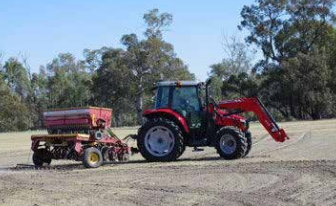The keys to successful pasture establishment
PRODUCTION ADVICE - FEBRUARY 2020 - AGRONOMY
By Adrian Smith
Senior Land Services Officer
Mixed Farming Systems
Fire, ongoing drought and increased grazing pressure may see the need for some producers to consider (re)establishing new pastures this year.
Establishment costs of new pastures can be quite high. We need to get good establishment in the first year to ensure the pasture is productive over the medium to long term.
What are the keys to successful pasture establishment?
 Planning
PlanningEstablishing new pastures can cost well over $200-300 per hectare, so it’s important to ensure you get a good result. Plan well in advance of sowing, considering factors such as soil limitations and weed and pest control.
- Soil fertility
A soil test will identify any soil issues that need correcting. Issues to look for are soil acidity, nutrient status and potential imbalances or toxicities (such as high aluminium levels).
- Choose the right variety
Choose your pasture species based on soil type, rainfall (or irrigation) requirements, maturity, and disease and waterlogging tolerance. A mix of legumes and grasses will provide high-quality pastures for your livestock.
Always use high-quality, certified seed. Seed cost is a relatively small component of the overall budget, and certified seed will ensure high germination rates and minimise impurities – especially weed seeds.
Seed treatment is also an important consideration. If sowing legumes, inoculation with the correct strain of rhizobia is essential, particularly where there is no recent history of legumes in the paddock. Local testing of rhizobia strains in pasture legumes (e.g. sub clover) has shown that pre-inoculated (coated) seed can be unreliable. If using pre-inoculated seed, ensure it is sown within six weeks of the inoculation date. Consider other seed treatments to minimise problems caused by pests and diseases.
- Correct seeding rate
Lowering seeding rates will result in lower production, while providing greater opportunity for weeds to germinate and establish. Always take note of the recommended seeding rate, and if conditions are less than ideal, consider increasing the rate.
- Sow with good soil moisture
Favourable conditions are desirable for at least a couple of weeks after sowing. When sowing dryland pastures, aim to sow with a good profile of moisture. Sowing into the late autumn-winter will reduce pasture establishment, growth and production.
- Soil temperature
Apart from the obvious issues around increased water requirements, high soil temperatures will inhibit germination of many annual pasture species. The ideal soil temperature (at sowing depth) for ryegrass is 15-250C. The most practical indicator is to use average daily air temperature over a period of 7-10 days.
- Seedbed preparation
Everyone has their own ideas of what works best for them – a prepared seedbed, direct drilling, broadcasting etc. Whatever method you choose, critical things to remember are:
- Sow seed shallow. Sowing too deep will significantly reduce germination and establishment, while dropping seed on the surface can often lead to ‘harvesting’ by ants, or the seed drying out before the root enters the soil.
- Aim to sow to a depth of 1-2 cm, cover lightly with soil, and get good seed-soil contact (use a rubber-tyred roller or similar).
- Monitor
Once your newly established pasture is on its way, keep an eye out for weed germinations and any pests – in particular red-legged earth mites and aphids. Get on top of these early, to minimise costs and any impacts on pasture productivity.
- Grazing management
Successful pastures, once established, are very dependent on suitable grazing management in their first year:
- Do not graze too early – plants must resist being ‘pulled out’
- Graze lightly to encourage tillering and good root development
- Ensure good seedset by minimising grazing during the flowering and seed production period.
Landholders wanting further advice on their pasture management should contact their consultants, advisors or resellers, or a member of the Agricultural Extension team at Murray Local Land Services.